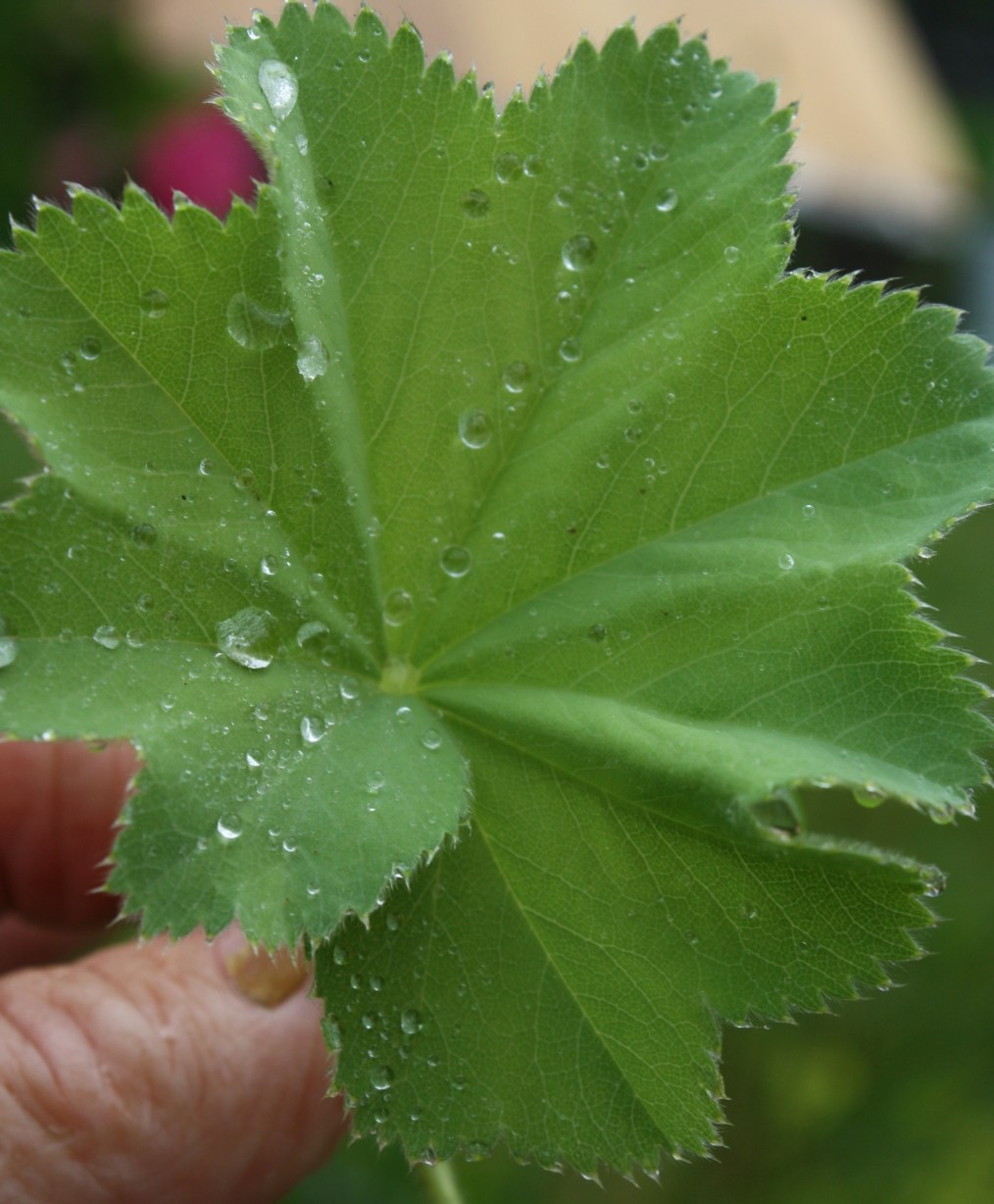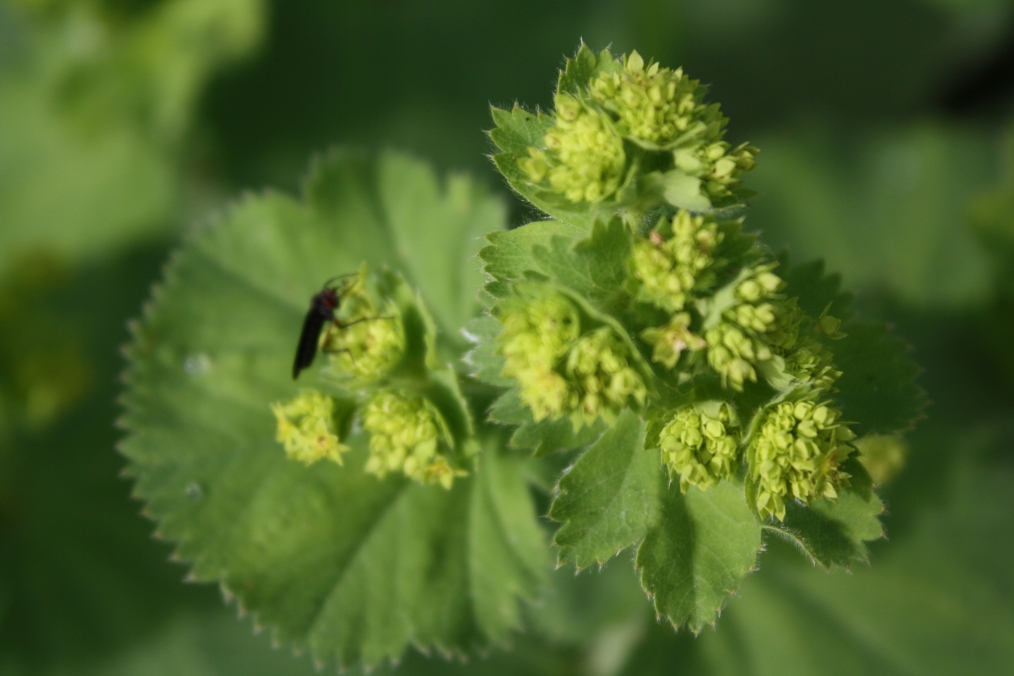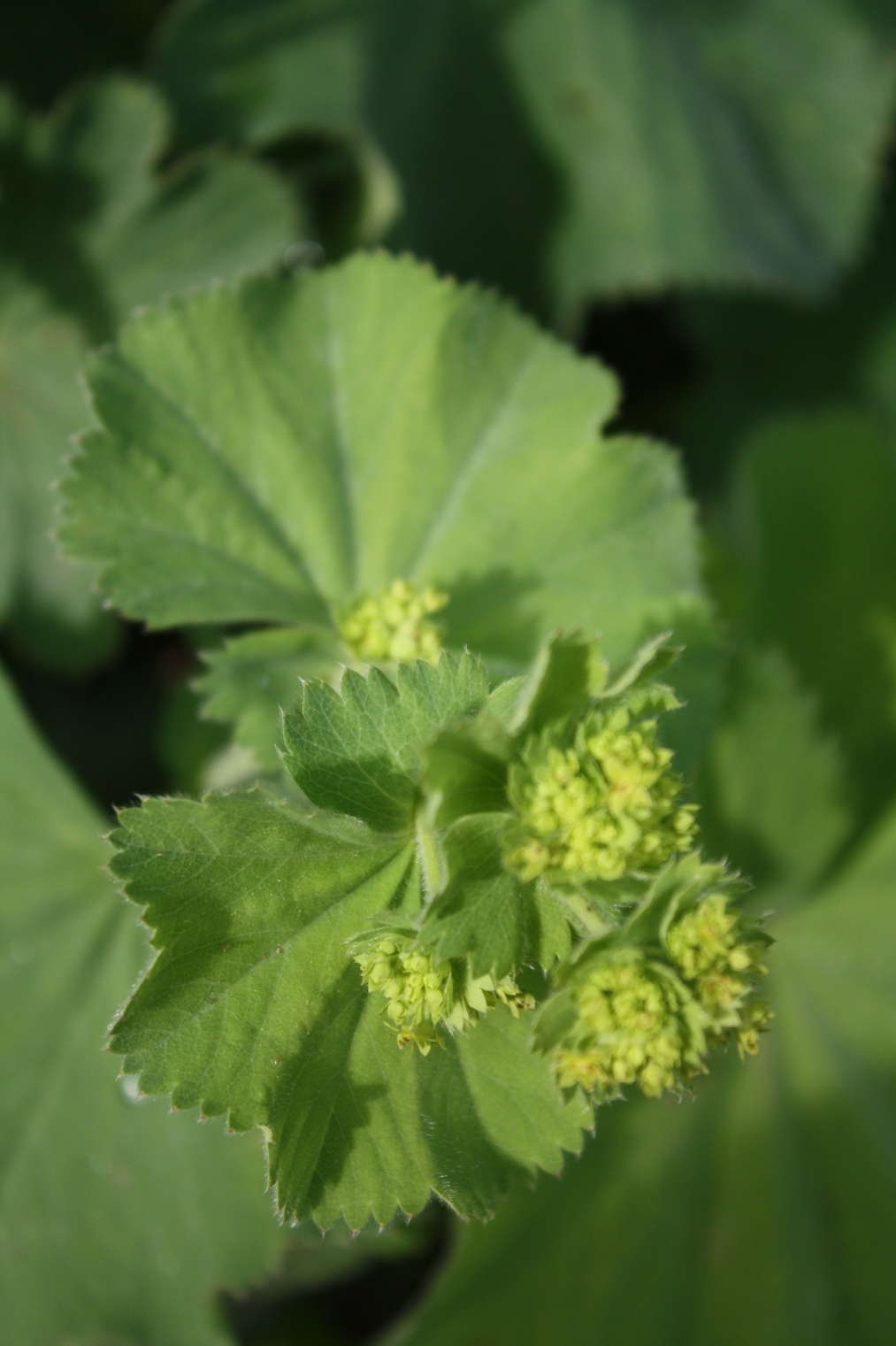OUR LADY’S MANTLE
Alchemilla vulgaris
ROSACEAE
Lately I’ve been sitting in the shade of a lovely plum tree here at the Blessed Maine Herb Farm, as the weather has been hot, and I appreciate the cool shade this plum tree’s graceful arching branches provide. The plum stands right next to a lush and lovely bed of Our Lady’s Mantle and so I’ve been enjoying its presence and watching the many pollinators working the flowers, since the plants are now in full and glorious bloom.
Our Lady’s Mantle has also been showing up prominently in my visits to other gardens, most recently while teaching a class at the beautiful Coastal Maine Botanical Gardens in Boothbay, Maine. This is a plant that I greatly value and I’d love to share with you here some of what I have come to know of this spectacular women’s herbal ally.
Regarded as an herb that offers a wealth of both magical and medicinal qualities, Our Lady’s Mantle spreads her wild-heart-woven healing cloak like a mantle of strength, wisdom and healing. As her common name implies, she does indeed have a special affinity for women.
Our Lady’s Mantle’s genus name, Alchemilla, is derived from the Arabic word alkemelych (alchemy), earned by virtue of its wondrous workings. I believe the old wives who say drops of dew (or its vascular secretions) held in the cup formed by the leaves of Our Lady’s Mantle is a magical elixir, enhancing the potency of any medicine it is added to. I like to lick and lap these waters up, and often offer them to visitors so they can experience the subtle healing energies too.
This delicate appearing, yet rugged, hardy and beautifully flowering herb has long been associated with the healing energies of the Divine Feminine in her personification as Earth Mother. In the beginning of the Christian era the plant became dedicated to Our Lady, the Blessed Mother.
In Germany, Our Lady’s Mantle is called frauenmantle, as its scalloped leaves resemble a lady’s cloak worn about the shoulders. In France it is pied-de-lion, lion’s foot, for its growing habit: big, wild lumps of lacy accordion-like leaves with delicate sprays of tiny yellow flowers. In Italy it is known as Madonna Mantello, or the Madonna’s cloak.
 If you look at each leaf closely, you will notice the leaves of Our Lady’s Mantle are actually formed by beautiful connecting hearts.
If you look at each leaf closely, you will notice the leaves of Our Lady’s Mantle are actually formed by beautiful connecting hearts.
During the Protestant Revolution, the name Our Lady’s Mantle was changed to its current, more generic form, Lady’s Mantle, in an effort to break the association with Mary, mother of Jesus. As a devotee of Mary, and in honor of the Divine Feminine from all times and cultures around the world, I prefer to call this plant by its long standing and original name, Our Lady’s Mantle.
Our Lady’s Mantle is an excellent uterine tonic and has a strengthening and astringent effect on the entire female reproductive system. To help regulate menstruation or control menstrual flooding, wild hearted wise women take 10 drops of lady’s mantle fresh plant tincture three times daily for a week or two before the expected onset of menstruation. Constituents such as astringent tannins and glycosides, salicylic acid and other sedatives make Our Lady’s Mantle an effective ally for those dealing with menstrual cramping or uterine discomfort. Our European grandmothers used it to help shrink fibroids.
Our Lady’s Mantle has a special affinity for the breasts and is a valuable ally for women dealing with breasts that are lumpy, swollen, or achy before menstruation. Regular use of this plant – either as a water based medicine consumed as a tea or used as a wash or compress, as an alcohol or vinegar tincture taken internally, or an oil used for external application, will restore tone to sagging breasts.
Poulticing with the fresh or dried plant material works well also. My friend Jan, dealing with sagging breasts after pregnancy and lactation, applied Our Lady’s Mantle poultices to her breasts several times a week and also massaged her breasts daily with an infused oil made from fresh leaves and flowers. She said that not only did Our Lady’s Mantle tone and firm her breast tissue it also helped ease her daily tension.
I prepare a formula I simply call Beautiful Breasts, with Our Lady’s Mantle as the primary ingredient, along with dandelion roots, blessed thistle, violet leaves and licorice. This formula has great success in smoothing out lumpy breast tissue, easing the pain of achy breasts and shrinking bumps and cysts. Breast Care Oil, applied topically, also contains Our Lady’s Mantle along with dandelion and violet leaves.
Many cultures have used Our Lady’s Mantle to ensure fertility and it is still in common use throughout the Middle East for this purpose. I make a delicious, hormone-nourishing, mineral-rich fertility brew with equal parts dried red clover blossoms, red raspberry leaves, wild grape leaves, and lady’s mantle leaves and flowers. I encourage women who want to conceive to use one ounce mixed herbs to a quart of water and make a full-strength infusion by steeping for at least 4 hours; drink 2-4 cups daily, sleep in the moonlight, and make love often, not just when ovulating. Studies show we’ve got to keep our hormones pumping all month long for optimum fertility cycles to occur. I suggest they begun gathering diapers and baby stuff because they’ll soon conceive.
The tannins in Our Lady’s Mantle help dry up excessive discharges, treat vaginitis, vulvitis, genital sores, and herpes, and heal perinea tears after childbirth. To treat these problems, I make a well-strained infusion for use as a sitz bath. For centuries, healers have used the infusion of its leaves and flowers as a wash or fomentation on wounds, especially those that are old or hard to heal. A blood coagulant, Our Lady’s Mantle quickly stops bleeding. Its astringent properties mean it will help resolve diarrhea as well.
Our Lady’s Mantle infusion can be used as a mouthwash after a tooth is pulled as it will stop the bleeding and speed healing. Used regularly as a mouthwash, it will soothe and astringe bleeding gums and can be used as a gargle to soothe a sore throat as well. A dropperful of the tincture can be put into water and used as a gargle or mouthwash, the same way you would use the infusion. Ancient legend tells us that adding a moisture-laden leaf to any magic pouch will seal your intention and magnify the power within.
Ancient legend tells us that adding a moisture-laden leaf to any magic pouch will seal your intention and magnify the power within.
Our Lady’s mantle tolerates a sunny spot, but is much happier with shade, such as that provided by the plum tree in our Blessed Maine Herb garden, at least for part of the day. The plant is very hardy here in Maine. We start seeds in early spring and set the plants out eight to ten weeks later.
The seedlings grow slowly and are a bit difficult to transplant when small, so we usually put them in a small protected bed to grow for a season before going out to their final homes. Our Lady’s Mantle plants grow to only a few inches in diameter the first year, but thereafter they come on strong and grow quickly. Mature plants produce a cluster of large, green, circular, fan-shaped leaves extending on foot-high slender stems from a base several feet wide. Tiny, yellowish-green flowers appear in mid-summer, springing out in loose clusters above the leaves. These flowers are much appreciated by florists and home decorators, as they add a nice airy touch to most flower bouquets.
I gather the leaves and flowers of Our Lady’s Mantle during the summer months at the peak of bloom. I tincture them while fresh in alcohol or vinegar, infuse them in oil and in honey and dry some on screens for teas and infusions.
Excerpted in part from Opening Our Wild Hearts to the Healing Herbs by Gail Faith Edwards
You’ll find our Hand crafted Certified Organic Our Lady’s Mantle tincture here: http://www.blessedmaineherbs.com/tinctures1.html
Beautiful Breasts and Fertility Tonic here: http://www.blessedmaineherbs.com/comfor.html
Breast Care Oil here: http://www.blessedmaineherbs.com/infusedoils.html



